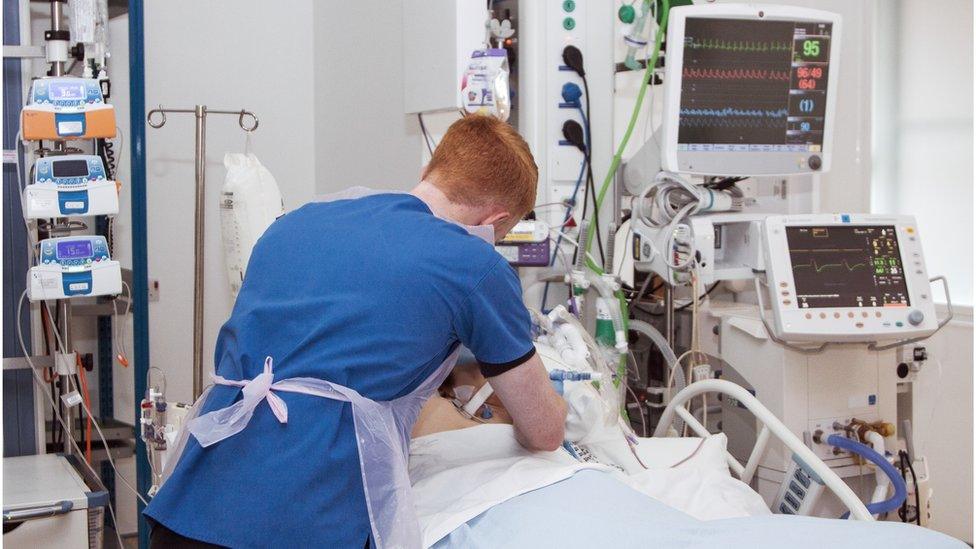Sepsis: Why can it be so hard to spot?
- Published
The tragic case of one-year-old William Mead, from Cornwall, who died of sepsis in 2014, has raised fresh concerns that the condition is not being spotted or treated early enough.

What is sepsis?

Sepsis happens when the body's immune system - the way the body responds to bugs and germs - goes into overdrive.
The initial problem can be quite mild and start anywhere - from a cut on the finger to a chest or urine infection, for example.
But when the immune system overreacts this can lead to an unintended but catastrophic attack on the body.
If left untreated this sets off a cascade of reactions - from shock to organ failure and even death.
There is a lot of research going on to attempt to find out what exactly triggers this sometimes fatal reaction.

How big a problem is it?

In severe cases, patients may need treatment in intensive care
An NHS England report, external suggests in 2014, more than 123,000 people suffered from sepsis.
And it estimates around 37,000 people die from it in England each year.
Meanwhile, the National Confidential Enquiry into Patient Outcome and Death, external (NCEPOD) published in November 2015, says sepsis kills more people than breast, bowel and prostate cancer combined in the UK.
The enquiry suggests there are as many as 200,000 cases of sepsis a year in the UK, and up to 60,000 deaths.
But Dr Alex Goodwin, author of the NCEPOD report, says the numbers recorded by the NHS are likely to be an underestimate because of the way data is coded.
Responding to the case of William Mead, Health Secretary Jeremy Hunt has said around 12,000 sepsis deaths a year may be avoidable.

Why can it be difficult to spot?

Experts say the crux of the problem is that sepsis can have a number of faces.
In some cases, it can be very obvious that a patient has low blood pressure and a high temperature.
And patients might breathe rapidly and have a racing pulse, for example.
But early on, all these symptoms can be mistaken for influenza or other infections.
And added to this is the advice to GPs to make sure they don't prescribe antibiotics inappropriately - particularly for viral flu infections.
But without early treatment, sepsis can be fatal and every hour can count.
And in some cases, there can be very few obvious symptoms at all - until it is too late.

What are the warning signs?
As the condition develops, symptoms may worsen and some more distinctive warning signs or "red flags" can emerge.
These vary from patient to patient, but after discussions with sepsis survivors the UK Sepsis Trust, external has compiled a list of the six most common signs.
They include:
Slurred speech or confusion
Extreme shivering or muscle pain
Passing no urine (in a day)
Severe breathlessness
"I feel like I might die"
Skin mottled or discoloured
A patient's blood pressure may plummet and red flags like these are signs that the body's organs, such as the lungs, brain and kidneys, are not getting enough blood and are beginning to fail.
In the case of babies and young children, some of these symptoms can present differently.
But experts caution it is important not to wait until red flags appear. And if they do, help must be sought immediately.

What can be done to improve sepsis care?

If spotted early, relatively simple treatment can be life-saving.
Patients may be given antibiotics and fluids through a drip. Oxygen may help too.
But once organs start to fail patients may need extra support in intensive care.
Experts say simple improvements could be made across the NHS to help prevent sepsis deaths.
The NCEPOD enquiry says there has been poor recording of patients' vital signs - their blood pressure and pulse for example - in both primary and hospital care.
Spotting a deterioration in these signs can help stop sepsis in its tracks.
The report recommends more doctors and nurses use early warning systems and screening checklists to prompt them to check for signs of sepsis.

What is being done?
NHS England published a wide-ranging sepsis action plan at the end of last year.
At the heart of it is the idea that staff across the NHS need to be trained to spot sepsis and be equipped to treat it correctly.
What is clear from the catalogue of failings highlighted by the case of William Mead is that this needs to apply to all frontline staff - from hospitals to helplines.
Last year, a campaign was set up in hospitals to help clinicians spot the signs quickly.
And Jeremy Hunt says a tool is now being developed to help better diagnosis of sepsis in primary care too.
When it comes to the helpline NHS 111, the health secretary says its algorithms need to be checked to make sure they are capable of flagging up sepsis.
Mr Hunt is also discussing the possibility of a public awareness campaign with Public Health England.
Meanwhile, more specific guidance for clinicians from the National Institute for Health and Care Excellence (NICE) is due this year.
- Published26 January 2016

- Published26 January 2016
- Published20 August 2014